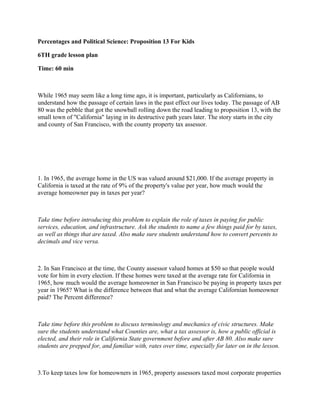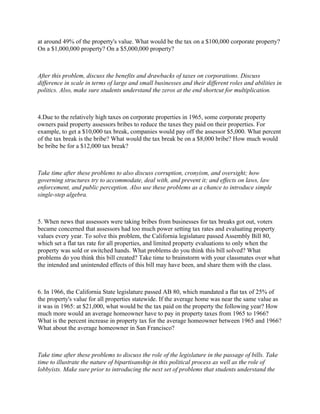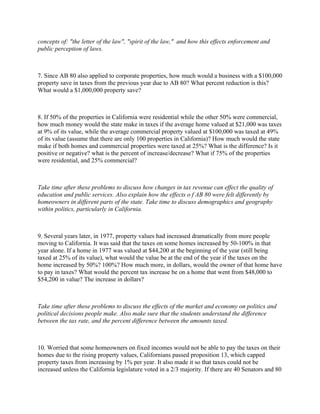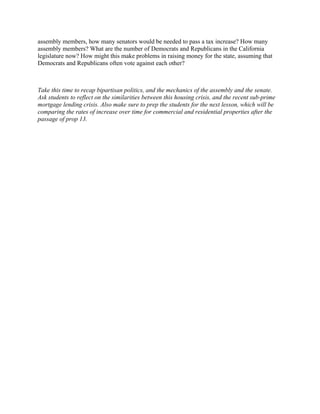Percentages and political science
- 1. Percentages and Political Science: Proposition 13 For Kids 6TH grade lesson plan Time: 60 min While 1965 may seem like a long time ago, it is important, particularly as Californians, to understand how the passage of certain laws in the past effect our lives today. The passage of AB 80 was the pebble that got the snowball rolling down the road leading to proposition 13, with the small town of "California" laying in its destructive path years later. The story starts in the city and county of San Francisco, with the county property tax assessor. 1. In 1965, the average home in the US was valued around $21,000. If the average property in California is taxed at the rate of 9% of the property's value per year, how much would the average homeowner pay in taxes per year? Take time before introducing this problem to explain the role of taxes in paying for public services, education, and infrastructure. Ask the students to name a few things paid for by taxes, as well as things that are taxed. Also make sure students understand how to convert percents to decimals and vice versa. 2. In San Francisco at the time, the County assessor valued homes at $50 so that people would vote for him in every election. If these homes were taxed at the average rate for California in 1965, how much would the average homeowner in San Francisco be paying in property taxes per year in 1965? What is the difference between that and what the average Californian homeowner paid? The Percent difference? Take time before this problem to discuss terminology and mechanics of civic structures. Make sure the students understand what Counties are, what a tax assessor is, how a public official is elected, and their role in California State government before and after AB 80. Also make sure students are prepped for, and familiar with, rates over time, especially for later on in the lesson. 3.To keep taxes low for homeowners in 1965, property assessors taxed most corporate properties
- 2. at around 49% of the property's value. What would be the tax on a $100,000 corporate property? On a $1,000,000 property? On a $5,000,000 property? After this problem, discuss the benefits and drawbacks of taxes on corporations. Discuss difference in scale in terms of large and small businesses and their different roles and abilities in politics. Also, make sure students understand the zeros at the end shortcut for multiplication. 4.Due to the relatively high taxes on corporate properties in 1965, some corporate property owners paid property assessors bribes to reduce the taxes they paid on their properties. For example, to get a $10,000 tax break, companies would pay off the assessor $5,000. What percent of the tax break is the bribe? What would the tax break be on a $8,000 bribe? How much would be bribe be for a $12,000 tax break? Take time after these problems to also discuss corruption, cronyism, and oversight; how governing structures try to accommodate, deal with, and prevent it; and effects on laws, law enforcement, and public perception. Also use these problems as a chance to introduce simple single-step algebra. 5. When news that assessors were taking bribes from businesses for tax breaks got out, voters became concerned that assessors had too much power setting tax rates and evaluating property values every year. To solve this problem, the California legislature passed Assembly Bill 80, which set a flat tax rate for all properties, and limited property evaluations to only when the property was sold or switched hands. What problems do you think this bill solved? What problems do you think this bill created? Take time to brainstorm with your classmates over what the intended and unintended effects of this bill may have been, and share them with the class. 6. In 1966, the California State legislature passed AB 80, which mandated a flat tax of 25% of the property's value for all properties statewide. If the average home was near the same value as it was in 1965: at $21,000, what would be the tax paid on the property the following year? How much more would an average homeowner have to pay in property taxes from 1965 to 1966? What is the percent increase in property tax for the average homeowner between 1965 and 1966? What about the average homeowner in San Francisco? Take time after these problems to discuss the role of the legislature in the passage of bills. Take time to illustrate the nature of bipartisanship in this political process as well as the role of lobbyists. Make sure prior to introducing the next set of problems that students understand the
- 3. concepts of: "the letter of the law", "spirit of the law," and how this effects enforcement and public perception of laws. 7. Since AB 80 also applied to corporate properties, how much would a business with a $100,000 property save in taxes from the previous year due to AB 80? What percent reduction is this? What would a $1,000,000 property save? 8. If 50% of the properties in California were residential while the other 50% were commercial, how much money would the state make in taxes if the average home valued at $21,000 was taxes at 9% of its value, while the average commercial property valued at $100,000 was taxed at 49% of its value (assume that there are only 100 properties in California)? How much would the state make if both homes and commercial properties were taxed at 25%? What is the difference? Is it positive or negative? what is the percent of increase/decrease? What if 75% of the properties were residential, and 25% commercial? Take time after these problems to discuss how changes in tax revenue can effect the quality of education and public services. Also explain how the effects o f AB 80 were felt differently by homeowners in different parts of the state. Take time to discuss demographics and geography within politics, particularly in California. 9. Several years later, in 1977, property values had increased dramatically from more people moving to California. It was said that the taxes on some homes increased by 50-100% in that year alone. If a home in 1977 was valued at $44,200 at the beginning of the year (still being taxed at 25% of its value), what would the value be at the end of the year if the taxes on the home increased by 50%? 100%? How much more, in dollars, would the owner of that home have to pay in taxes? What would the percent tax increase be on a home that went from $48,000 to $54,200 in value? The increase in dollars? Take time after these problems to discuss the effects of the market and economy on politics and political decisions people make. Also make sure that the students understand the difference between the tax rate, and the percent difference between the amounts taxed. 10. Worried that some homeowners on fixed incomes would not be able to pay the taxes on their homes due to the rising property values, Californians passed proposition 13, which capped property taxes from increasing by 1% per year. It also made it so that taxes could not be increased unless the California legislature voted in a 2/3 majority. If there are 40 Senators and 80
- 4. assembly members, how many senators would be needed to pass a tax increase? How many assembly members? What are the number of Democrats and Republicans in the California legislature now? How might this make problems in raising money for the state, assuming that Democrats and Republicans often vote against each other? Take this time to recap bipartisan politics, and the mechanics of the assembly and the senate. Ask students to reflect on the similarities between this housing crisis, and the recent sub-prime mortgage lending crisis. Also make sure to prep the students for the next lesson, which will be comparing the rates of increase over time for commercial and residential properties after the passage of prop 13.




